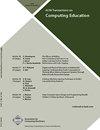计算思维和概念机器:缺失的环节
IF 3.8
3区 工程技术
Q1 EDUCATION, SCIENTIFIC DISCIPLINES
引用次数: 0
摘要
在学习编程和理解编程语言如何控制计算机的过程中,学习者在逐渐完善心智模型的同时,也会产生洞察力和误解。重要的是,学习者能够区分计算机的不同元素和角色(例如编译器,解释器,内存等),这是新手程序员可能难以理解的。形成准确的心智模型是与掌握计算概念和过程以及学习计算机编程密不可分的潜在困难来源之一。通常使用某种形式的表示(例如抽象机器或计算代理)来支持技术或教学解释。概念机(NM)是一种包含一个或多个计算概念的教学设备,最初被描述为使用特定编程语言结构进行操作的理想计算机。它可以用来支持特定的或一般的学习目标,并且通常会有一些可以参考的具体表示。计算思维(Computational Thinking, CT)被定义为一种用于解决[计算]问题的思维方式,通常表现为使用计算代理(Computational Agent, CA)来执行解决方案所呈现的信息处理。在CT中,典型的目标是生成算法或计算机程序,CA的作用似乎与NM非常相似。尽管它在不同的发展阶段(学习者和课程)中有所变化,但ca和NMs的角色可以被视为连接学习者心智模型和课程概念模型的通用工具。在本文中,我们将研究ca和NMs之间的关系,并指出它们如何看待不同的学习阶段。我们遍历了这些概念的定义和用法的范围,并阐明了在文献中如何看待这些概念的清晰模型。这包括探索机器和代理的本质,以及这些历史观点与现代计算教育学的关系。我们认为CA可以被看作是NM的一个抽象的、简化的变体,它为学习者提供了一个有用的视角,以支持他们更有效地形成NMs的鲁棒心理模型。我们建议,编程教学应该在学习的不同阶段利用CA的概念,将学习者的心智模型与完整的NM连接起来。本文章由计算机程序翻译,如有差异,请以英文原文为准。
Computational Thinking and Notional Machines: The Missing Link
In learning to program and understanding how a programming language controls a computer, learners develop both insights and misconceptions whilst their mental models are gradually refined. It is important that the learner is able to distinguish the different elements and roles of a computer (e.g. compiler, interpreter, memory, etc.), which novice programmers may find difficult to comprehend. Forming accurate mental models is one of the potential sources of difficulty inextricably linked to mastering computing concepts and processes, and for learning computer programming. It is common to use some form of representation (e.g. an abstract machine or a computational agent) to support technical or pedagogic explanations. The Notional Machine (NM) is a pedagogical device that entails one or more computational concepts, originally described as an idealised computer operating with the constructs of a particular programming language. It can be used to support specific or general learning goals and will typically have some concrete representation that can be referred to. Computational Thinking (CT), which is defined as a way of thinking that is used for [computational] problem solving, is often presented as using a Computational Agent (CA) to carry out information processing presented by a solution. In CT, where the typical goal is to produce an algorithm or a computer program, the CA seemingly serves a purpose very similar to an NM. Although it changes through the different stages of development (of the learner and of the curriculum), the roles of CAs and NMs can be seen as versatile tools that connect a learner’s mental model with the conceptual model of a program. In this article we look at this relationship between CAs and NMs, and indicate how they would look at different stages of learning. We traverse the range of definitions and usages of these concepts, and articulate models that clarify how these are viewed in the literature. This includes exploring the nature of machines and agents, and how historical views of these relate to modern pedagogy for computation. We argue that the CA can be seen as an abstract, simplified variant of an NM that provides a useful perspective to the learner to support them to form robust mental models of NMs more efficiently and effectively. We propose that teaching programming should make use of the idea of a CA at different stages of learning, as a link that connects a learner’s mental model to a full NM.
求助全文
通过发布文献求助,成功后即可免费获取论文全文。
去求助
来源期刊

ACM Transactions on Computing Education
EDUCATION, SCIENTIFIC DISCIPLINES-
CiteScore
6.50
自引率
16.70%
发文量
66
期刊介绍:
ACM Transactions on Computing Education (TOCE) (formerly named JERIC, Journal on Educational Resources in Computing) covers diverse aspects of computing education: traditional computer science, computer engineering, information technology, and informatics; emerging aspects of computing; and applications of computing to other disciplines. The common characteristics shared by these papers are a scholarly approach to teaching and learning, a broad appeal to educational practitioners, and a clear connection to student learning.
 求助内容:
求助内容: 应助结果提醒方式:
应助结果提醒方式:


